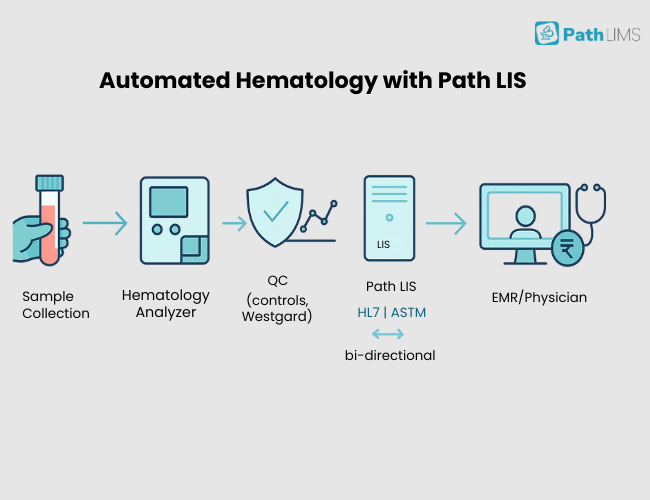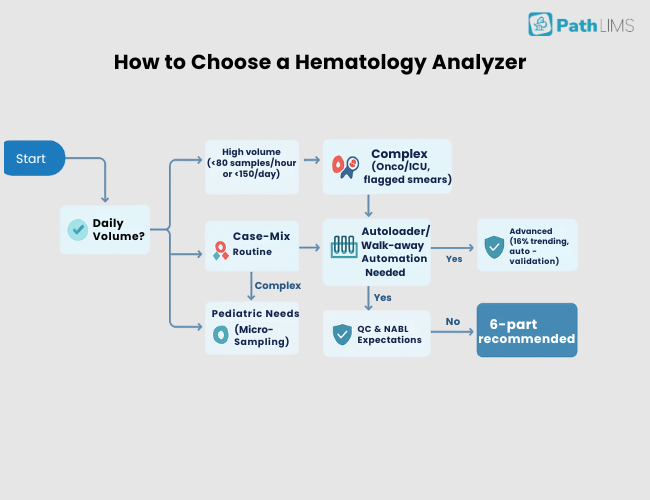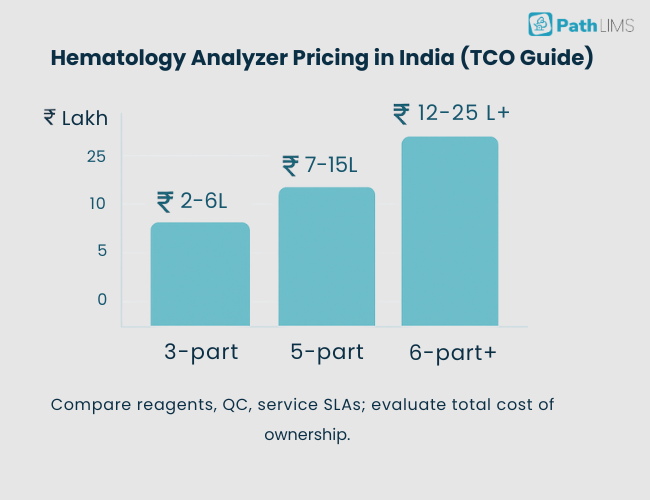“Best” isn’t one model—it’s the one that fits your sample volume, reporting needs, budget, and staff skill. A small-town lab may need reliability and low maintenance. A high-throughput center may value walk-away automation and 6-part diff flags. Let’s match features to real-world use.
What hematology analyzers do

Hematology analyzers run CBCs and differentials, reporting red cells, white cells, platelets, and flags that prompt slide review. A 5-part diff separates neutrophils, lymphocytes, monocytes, eosinophils, and basophils. A 6-part adds immature granulocytes for finer clinical context.
At a Glance
Whether you call it a hematology analyzer, haematology analyser, or simply a hematology machine, today’s platforms blend automated hematology with smart flags and LIS connectivity. In India’s digital healthcare push, automation in haematology and wider pathology automation (paired with strong hematology quality control) cut turnaround time and errors. Below is a quick view of specs, pros/cons, and the typical price of a hematology analyzer model you’ll see in Indian labs.
| Analyzer | Pros | Cons | Approx Price (₹) | Best For |
|---|---|---|---|---|
| Sysmex XN-550 | 6-part diff with RET/NRBC options, reliable QC system, compact design | Higher price, requires Sysmex reagents | 14–17 Lakh | Advanced labs handling oncology or high-end diagnostics |
| Mindray BC-6200 | High throughput, low reagent use, NRBC included, value pricing | Large footprint, limited to 5-part diff | 8.5–21.5 Lakh | Growing diagnostic centers balancing volume and cost |
| Beckman Coulter LH750 | Fully automated, high throughput (120 samples/hr), LIS connectivity, closed-tube safety | Higher reagent consumption; large footprint | 15–20 Lakh | Medium to large diagnostic centers requiring reliability and automation |
| Horiba ABX Pentra series | Simple reagent system (only 2), 6-part diff, compact footprint | Slightly limited autoload capacity | ~8 Lakh | Labs seeking 6-part accuracy with simple maintenance |
| Erba H360 | Flow cytometry tech, continuous rack loading, micro-sampling | Fewer service points in smaller cities | ~10 Lakh | Labs prioritizing automation and continuous workflow |
Deeper Insights Into Each Hematology Analyzer Device

Sysmex XN-550
A compact 6‑part differential analyzer that runs CBCs with IGs, optional RET/NRBC, and walk‑away rack sampling for small to mid‑volume labs. As part of the Sysmex hematology portfolio, the XN‑550 is among the most trusted Sysmex hematology analyzers used in India.
Pros
High clinical detail with 6‑part diff, strong flagging, small sample needs, and minimal footprint for crowded benches.
Cons
Higher capital and reagent costs versus many 5‑part systems; vendor‑locked consumables.
Best for
Centers handling oncology, complex cases, or those wanting fewer manual smear reviews with reliable IG reporting.
Mindray BC-6200
A value‑oriented 5‑part analyzer with up to 110 tests per hour and a 50‑tube autoloader, reporting CBC+DIFF with NRBC. If you’re comparing a Mindray hematology analyzer (often searched as “hematology analyzer Mindray”), the BC‑6200 balances speed and cost for busy centers.
Pros
Fast throughput, economical operation, and good walk‑away time reduce hands‑on work and per‑test costs.
Cons
Five‑part differential limits IG reporting; footprint is larger than ultra‑compact units.
Best for
Busy diagnostic centers seeking speed and predictable running costs without moving to premium 6‑part pricing.
Beckman Coulter LH750
A fully automated 5‑part platform designed for higher volumes, with robust data management, LIS connectivity, and closed‑tube operation.
Pros
High throughput with stable precision, automation that reduces error, and strong traceability for audits.
Cons
Larger bench space and potentially higher reagent use than compact analyzers; premium service contracts.
Best for
Medium to large labs prioritizing uptime, automation, and compliance‑ready data trails.
Horiba ABX Pentra series
A compact line that offers 6‑part options in select models, streamlined reagent systems, and practical STAT access for routine workflows. The ABX Pentra is a popular Horiba CBC machine (a Horiba cell counter) for compact 6‑part routines.
Pros
Simple daily maintenance, lean reagent schemes, and a small footprint that suits satellite or start‑up labs.
Cons
Autoload capacity and ecosystem breadth can be narrower than big‑three vendors.
Best for
Labs wanting 6‑part capability at a friendly price with less complexity in consumables.
Erba H360
A 5‑part analyzer positioned for automated mid‑range workloads, with micro‑sampling and continuous operation in typical configurations.
Pros
Solid automation and practical throughput with accessible pricing and service in many Indian metros.
Cons
Service depth can vary by region; fewer advanced specialty flags than premium 6‑part systems.
Best for
Centers upgrading from 3‑part to reliable 5‑part automation without premium costs.
Ownership costs and practical notes
Beyond the sticker price, compare reagent packs, waste, calibrators, and controls. Some platforms highlight low sample and reagent volumes that reduce running costs over time. Service contracts and uptime guarantees matter more than saving a few rupees up front.
Connectivity & Workflow: LIS (Path LIS) & Billing
Seamless LIS connectivity—whether you use Path LIS or another system—ensures orders/results sync automatically with EMRs and lab billing software for laboratories. Look for HL7/ASTM interfaces, bi‑directional orders, and auto‑validation rules. This is where hematology automation meets broader laboratory automation equipment and pathology automation to boost cash flow and compliance.
Quality Control & NABL Accreditation
To satisfy the scope of NABL accreditation (ISO 15189), demonstrate traceable hematology quality control: daily 2–3 level controls, Levy‑Jennings charts, Westgard rules, calibration logs, and maintenance records. Many platforms—especially Sysmex hematology systems—offer built‑in QC management and LIS exports that make audits smoother.
Pricing Snapshot in India
- 3‑part analyzers: ₹2–6 lakh
- 5‑part analyzers: ₹7–15 lakh
- 6‑part / higher automation: ₹12–25+ lakh (autoloaders, NRBC/RET options, service)
Always compare bundled reagent pricing, service SLAs, and warranties—the real price of a hematology analyzer is total cost of ownership (TCO).

Why automated hematology matters in Digital Healthcare India
In India’s digital healthcare landscape, automation in haematology reduces pre‑analytical/analytical errors, speeds reporting, and frees staff to focus on critical flags. Pair analyzers with robust LIS, auto‑validation, and barcoding to unlock true end‑to‑end efficiency.
Conclusion
Shortlist around your case‑mix, volumes, automation goals, and QC/NABL needs. For lean, high‑speed 5‑part automation, Mindray BC‑6200 is compelling. For compact 6‑part precision, Sysmex XN‑550 and Horiba ABX Pentra stand out. For enterprise‑grade walk‑away automation, Beckman Coulter LH750 suits larger centers. Erba H360 offers pragmatic mid‑range value. Pilot the shortlisted units in your workflow and compare live flags, reagent use, service SLAs, and LIS connectivity before you sign.
FAQs
What’s the difference between 5-part and 6-part hematology analyzers?
A 5-part splits WBCs into five subtypes. A 6-part adds immature granulocytes, which can aid earlier flagging in infections and hematologic disease, potentially reducing manual reviews.
Do I need a 6-part analyzer for a new lab?
Not always. Many new labs start with a robust 5-part and add 6-part later if case-mix demands it. Consider slide review capacity and clinician expectations in your area.
How much does a hematology analyzer cost in India?
Prices vary widely by model and bundle. Market listings span from a few lakhs for 3-part units to well above ₹10–20 lakh for automated 5-/6-part platforms. Always get formal quotes and compare service—in other words, evaluate the price of a hematology analyzer as TCO.
Which analyzer is best for pediatric settings?
Platforms with low aspiration volumes and closed-tube operation reduce redraws and exposure—Sysmex XN-550 (micro-sampling) and select Horiba ABX Pentra models are safe choices in compact 6-part setups.
Platforms with low aspiration volumes and closed-tube operation reduce redraws and exposure—DxH 520 is designed with 17 µL aspiration and closed-vial safety.
What affects ongoing costs the most?
Reagent consumption, controls, calibrators, and waste handling drive per-test costs. Systems designed for low sample and reagent volumes can lower lifetime ownership costs. Strong hematology quality control and LIS-driven auto-validation also prevent re-runs.
Table of Contents
- What hematology analyzers do
- At a Glance
- Deeper Insights Into Each Hematology Analyzer Device
- Ownership costs and practical notes
- Connectivity & Workflow: LIS (Path LIS) & Billing
- Quality Control & NABL Accreditation
- Pricing Snapshot in India
- Why automated hematology matters in Digital Healthcare India
- Conclusion
- FAQs




